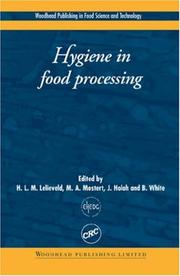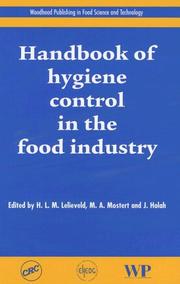| Listing 1 - 9 of 9 |
Sort by
|
Book
ISBN: 1613447981 0857094939 184569564X 9781613447987 9781845695644 9780857094933 Year: 2011 Publisher: Cambridge Philadelphia Woodhead Publishing
Abstract | Keywords | Export | Availability | Bookmark
 Loading...
Loading...Choose an application
- Reference Manager
- EndNote
- RefWorks (Direct export to RefWorks)
Food safety is vital for consumer confidence, and the hygienic design of food processing facilities is central to the manufacture of safe products. Hygienic design of food factories provides an authoritative overview of hygiene control in the design, construction and renovation of food factories.The business case for a new or refurbished food factory, its equipment needs and the impacts on factory design and construction are considered in two introductory chapters. Part one then reviews the implications of hygiene and construction regulation in various countries on food factory design.
Chemistry, Technical. --- Food industry and trade -- Automation. --- Food processing plants -- Design -- Handbooks, manuals, etc. --- Manufacturing processes -- Design -- Handbooks, manuals, etc. --- Food processing plants --- Food industry and trade --- Food adulteration and inspection. --- Safety measures. --- Engineering --- Food Science and Technology --- Analysis of food --- Food --- Food, Pure --- Food inspection --- Inspection of food --- Pure food --- Adulterations --- Consumer protection --- Public health --- Sanitary chemistry --- Agricultural processing plants --- Adulteration --- Inspection --- Voedselveiligheid --- Voedingsindustrie --- Voedingshygiëne --- 664.74
Book
ISBN: 0857098632 0857094297 9780857098634 9780857094292 9780857094292 Year: 2014 Publisher: Oxford
Abstract | Keywords | Export | Availability | Bookmark
 Loading...
Loading...Choose an application
- Reference Manager
- EndNote
- RefWorks (Direct export to RefWorks)
The hygienic processing of food concerns both the potential hazards in the food products and the regulation, design and management of food processing facilities. This second edition of Hygiene in food processing gives a revised overview of the practices for safe processing and incorporates additional chapters concerning pest control, microbiological environmental sampling and the economics of food plants.Part one addresses the risks of microbial foods and the corresponding regulation in the EU. Part two discusses the hygienic design of food factory infrastructure, encompassing the desi
Food industry and trade -- Sanitation. --- Food law and legislation. --- Food processing plants -- Design. --- Food industry and trade --- Food processing plants --- Food law and legislation --- Chemical & Materials Engineering --- Engineering & Applied Sciences --- Chemical Engineering --- Sanitation --- Design and construction --- Sanitation. --- Health aspects. --- Design and construction. --- Food --- Food, Pure --- Pure food --- Commercial law --- Consumer protection --- Produce trade --- Agricultural processing plants --- Food preparation industry --- Food processing --- Food processing industry --- Food technology --- Food trade --- Agricultural processing industries --- Processed foods --- Food-plant sanitation --- Law and legislation --- Processing
Book
ISBN: 0081001975 008100155X 1787850218 9780081001974 9780081001554 9781787850217 Year: 2016 Publisher: Amsterdam
Abstract | Keywords | Export | Availability | Bookmark
 Loading...
Loading...Choose an application
- Reference Manager
- EndNote
- RefWorks (Direct export to RefWorks)
Food industry and trade --- Sanitation. --- Health aspects. --- Food --- Food preparation industry --- Food processing --- Food processing industry --- Food technology --- Food trade --- Agricultural processing industries --- Processed foods --- Food-plant sanitation --- Processing

ISBN: 1855734664 0849312124 9786610373208 1280373202 1855737051 1591249244 9781855737051 0203487680 9780203487686 9781855734661 9780849312120 Year: 2003 Publisher: Cambridge Boca Raton, FL Woodhead Pub. CRC Press
Abstract | Keywords | Export | Availability | Bookmark
 Loading...
Loading...Choose an application
- Reference Manager
- EndNote
- RefWorks (Direct export to RefWorks)
A high standard of hygiene is a prerequisite for safe food production, and the foundation on which HACCP and other safety management systems depend. Edited and written by some of the world's leading experts in the field, and drawing on the work of the prestigious European Hygienic Engineering and Design Group (EHEDG), Hygiene in food processing provides an authoritative and comprehensive review of good hygiene practice for the food industry.Part one looks at the regulatory context, with chapters on the international context, regulation in the EU and the USA. Part two looks at the key i
Engineering --- Food Science and Technology --- Food industry and trade --- Food processing plants --- Food law and legislation --- Chemical & Materials Engineering --- Engineering & Applied Sciences --- Chemical Engineering --- Food --- Food, Pure --- Pure food --- Commercial law --- Consumer protection --- Produce trade --- Agricultural processing plants --- Food preparation industry --- Food processing --- Food processing industry --- Food technology --- Food trade --- Agricultural processing industries --- Processed foods --- Food-plant sanitation --- Sanitation --- Health aspects --- Design and construction --- Law and legislation --- Processing --- FOOD HANDLING --- FOOD CONTAMINATION --- FOOD-PROCESSING INDUSTRY --- PREVENTION AND CONTROL --- Food law and legislation. --- Food contamination --- Food handling. --- Sanitation. --- Design. --- Prevention.

ISBN: 1855739577 9781855739574 084933439X 1280361794 9786610361793 1845690532 9781845690533 9780849334399 Year: 2005 Publisher: Boca Raton Cambridge, England CRC Press Woodhead Pub.
Abstract | Keywords | Export | Availability | Bookmark
 Loading...
Loading...Choose an application
- Reference Manager
- EndNote
- RefWorks (Direct export to RefWorks)
Complementing the highly successful Hygiene in food processing, this book reviews recent research on improving hygiene in food processing. Part 1 considers recent research on contamination risks such as biofilms and how they can be assessed. Part 2 reviews ways of improving hygienic design of both buildings and equipment, including clean room technology. The final part of the book discusses ways of improving hygiene practice and management.
664.019 --- 613.6 --- 66.013.8 --- 613.2 --- 664.74 --- HACCP --- Voedselveiligheid --- 664.019 Faults and defects of preserved foodstuffs. Food contamination. Contaminants --- Faults and defects of preserved foodstuffs. Food contamination. Contaminants --- 66.013.8 Industrial hygiene. Sanitation. Other accessory services --- Industrial hygiene. Sanitation. Other accessory services --- Occupational hazards. Industrial health and hygiene --- Food industry and trade --- Food processing plants --- Manufacturing processes --- Food contamination --- Surface contamination --- Contamination (Technology) --- Surfaces (Technology) --- Contaminated food --- Food --- Foods, Contaminated --- Food adulteration and inspection --- Industrial processing --- Manufacture --- Process engineering (Manufactures) --- Processes, Manufacturing --- Processing, Industrial --- Production processes --- Industrial arts --- Production engineering --- Machine-tools --- Materials --- Agricultural processing plants --- Food preparation industry --- Food processing --- Food processing industry --- Food technology --- Food trade --- Agricultural processing industries --- Processed foods --- Sanitation --- Health aspects --- Risk management --- Equipment and supplies --- Design --- Prevention --- Contamination --- Processing
Book
ISBN: 012816011X 0128160128 9780128160114 Year: 2022 Publisher: London, England : Academic Press,
Abstract | Keywords | Export | Availability | Bookmark
 Loading...
Loading...Choose an application
- Reference Manager
- EndNote
- RefWorks (Direct export to RefWorks)
Ensuring Global Food Safety: Exploring Global Harmonization, Second Edition, examines the policies and practices of food law which remain top contributors to food waste. This fully revised and updated edition offers a rational and multifaceted approach to the science-based issue of "what is safe for consumption?" and how creating a globally acceptable framework of microbiological, toxicological and nutritional standards can contribute to the alleviation of hunger and food insecurity in the world. Currently, many laws and regulations are so stringent that healthy food is destroyed based on scientifically incorrect information upon which laws and regulations are based. This book illuminates these issues, offering guidelines for moving toward a scientifically sound approach to food safety regulation that can also improve food security without putting consumers at risk.
Food supply. --- Food control --- Produce trade --- Agriculture --- Food security --- Single cell proteins --- Food industry and trade --- Food --- Food Safety --- Legislation, Food --- Global Health --- Safety measures --- International cooperation. --- Safety regulations. --- Global Harmonization Initiative (Association)
Book
ISBN: 032390209X 0128200138 9780128200131 9780323902090 Year: 2022 Publisher: Amsterdam
Abstract | Keywords | Export | Availability | Bookmark
 Loading...
Loading...Choose an application
- Reference Manager
- EndNote
- RefWorks (Direct export to RefWorks)
Food Safety Management: A Practical Guide for the Food Industry, Second Edition continues to present a comprehensive, integrated and practical approach to the management of food safety throughout the production chain. While many books address specific aspects of food safety, no other book guides you through the various risks associated with each sector of the production process or alerts you to the measures needed to mitigate those risks. This new edition provides practical examples of incidents and their root causes, highlighting pitfalls in food safety management and providing key insights into different means for avoiding them. Each section addresses its subject in terms of relevance and application to food safety and, where applicable, spoilage. The book covers all types of risks (e.g., microbial, chemical, physical) associated with each step of the food chain, making it an ideal resource. Addresses risks and controls at various stages of the food supply chain based on food type, including a generic HACCP study and new information on FSMA Covers the latest emerging technologies for ensuring food safety Includes observations on what works and what doesn't on issues in food safety management Provides practical guidelines for the implementation of elements of the food safety assurance system Explains the role of different stakeholders of the food supply.
Food industry and trade --- Safety measures. --- Food handling --- Management.
Book
ISBN: 0128226196 0128226188 9780128226193 9780128226186 Year: 2021 Publisher: Oxford
Abstract | Keywords | Export | Availability | Bookmark
 Loading...
Loading...Choose an application
- Reference Manager
- EndNote
- RefWorks (Direct export to RefWorks)
Food processing plants --- Agricultural processing plants --- Design and construction.
Book
ISBN: 1845693833 1845690583 9781845693831 9781845690588 9781420043952 1420043951 Year: 2007 Publisher: Cambridge Woodhead
Abstract | Keywords | Export | Availability | Bookmark
 Loading...
Loading...Choose an application
- Reference Manager
- EndNote
- RefWorks (Direct export to RefWorks)
Pulsed electric field (PEF) food processing is a novel, non-thermal preservation method that has the potential to produce foods with excellent sensory and nutritional quality and shelf-life. This important book reviews the current status of the technology, from research into product safety and technology development to issues associated with its commercial implementation.Introductory chapters provide an overview of the process and its history. Part one then discusses the technology of PEF food preservation, with chapters on circuitry and pulse shapes, chamber design and technical and s
Food --- Electric fields --- Preservation. --- Industrial applications. --- Field theory (Physics) --- Electromagnetic fields --- Food preservation --- Food preservatives
| Listing 1 - 9 of 9 |
Sort by
|

 Search
Search Feedback
Feedback About UniCat
About UniCat  Help
Help News
News